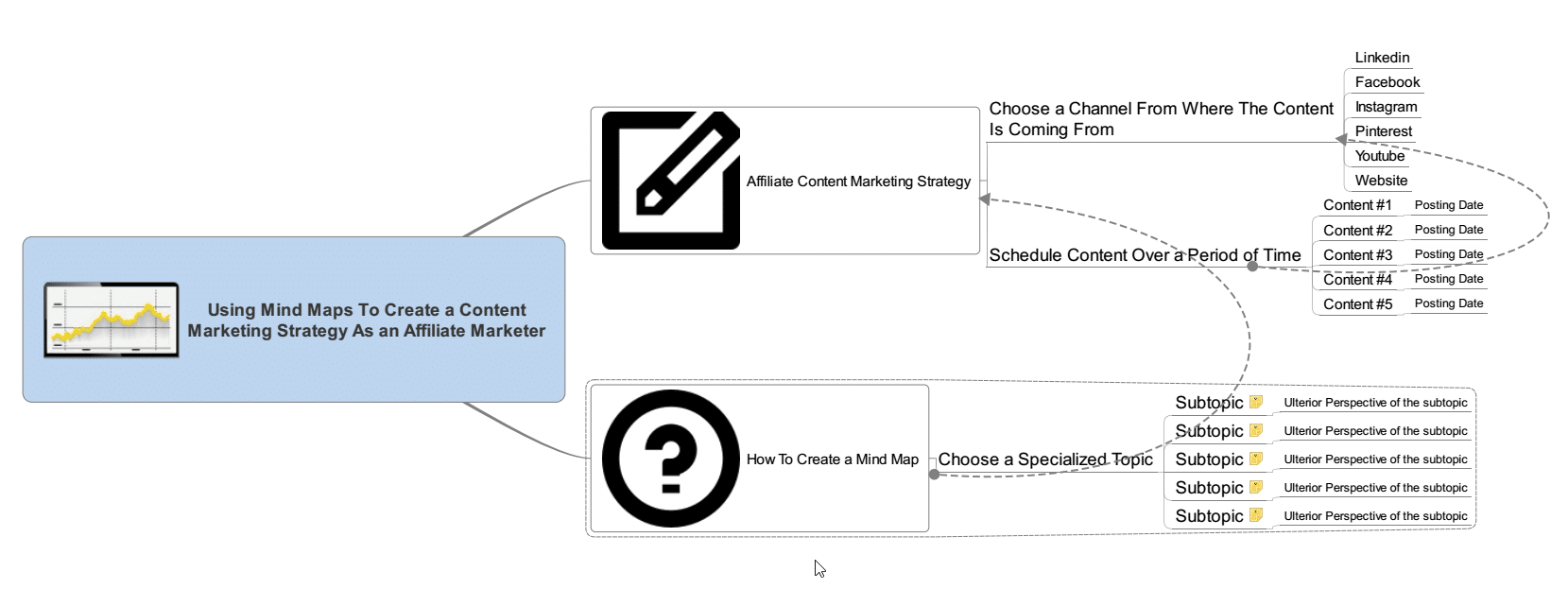Content creation can be a complicated process for the full-time content creator and affiliate marketer in need of writing new and exciting content on a weekly basis. The majority of bloggers are creating more content than ever before. It can be quite stressful to produce varied content regularly for the increasing attention span deficit. One of the best ways to come up with interesting content for affiliate marketing is the mind map.
The process of mind mapping or brainstorming has been around for centuries, but it is becoming more and more useful in everyday life. Mind maps help by visually showing ideas and organizing them allowing for expansion on ideas as well as grouping them and categorizing topics to help you work past your writer’s block and put out your content regularly.
There are a few techniques we can look at that will help bring you from struggling to produce content to churning out content like never before.
Use Mind-Mapping Software
Creating a mind map from the ground up can be a daunting task and that’s where mind mapping software comes in to make the work a whole lot easier.
Digital mind maps don’t create a mess for you to clean up later and can be formed in a matter of seconds. They also make editing the mind map just as easy as well as saving to a cloud so that you can work on it wherever you go.

Many mind mapping tools exist, and one that comes highly recommended is iMindQ. It has a free trial as well as paid versions with features such as adding images, logos, other attachments, as well as light speed exporting. iMindQ allows you to create the best mind maps and charts to organize your thoughts and keep the creative juices flowing.
5 Steps to Effective Mind Map Creation Use these steps to create the best and most effective mind maps and organize your thoughts.
1. Choose a specialized topic.
What can you specialize in that will grab your viewer’s attention?
You don’t have to recreate the wheel here. Look at the work you have already put out and chosen something that you already find interesting or that your viewers have received well.
The subject matter can also come from other content such as a recent publication, film, or article. Notate the source of the subject matter as well as where it links to your content. Think about where the subject matter can have its own primary page on your website.
Can you link to a video on YouTube? This initial page can be the home of your topic where you can link as many posts as possible to it. Remember to keep your content relevant to your specialization.
2. Come up with five subtopics.
Start thinking about everything to do with the topic at hand. What is the definition? How is it put into practice? What are the benefits of this topic? Can anything help you make this topic or method easier? Always think about closing thoughts.
What do you want to leave people thinking about your topic?
Breaking the topic down into manageable subtopics will help you expand upon it and generate more content than if you kept it broad and general.
It also allows you to keep your articles shorter and more specialized which in turns ups the quality and usefulness to the readers.
3. Create a number of different perspectives on the subtopics.
What will be the best way to explain each subtopic?
A quote?
A graphic?
A video?
This step creates a number of links for the primary topic that bring traffic to your website. You can then use these as topics themselves and create additional content.
Just think if you come up with five perspectives on each subtopic that gives you 25 links to the primary topic. Think about the different angles that you could look at a particular topic. There is always more than one way of looking at something.
You can drive different types of viewers to your website if you provide different viewpoints or methods of thinking about topics. Think of it as a funnel. With one funnel you only have one particular type of viewer. With multiple funnels, you have numerous types of viewers. It pays to broaden your perspective on a topic.
4. What channel is the content coming from?
How will you distribute your message? Think about the characteristics of the medium you have chosen.
LinkedIn differs from Facebook because its users expect formal writing.
Whatever channel you want to make sure to adhere to the expectations of the viewers, or you may not draw in the traffic you wish.
You may brainstorm different channels such as posting a link of an article to Twitter or linking a summary of the material on LinkedIn. Create a graphic that is relevant to your topic and post it on Instagram or Pinterest.
Post a brief description of the topic on your company’s website. Record an informational video and post it on YouTube. Link to a client’s content or to other influencers’ websites.
5. Schedule the content over a long period of time.
You are now ready to schedule your posts. You must decide when you want to draw attention to your topics.
Usually, you will want to post your content over a more extended period of time at different times during the day. This is the best way to get the most viewers unless of course, your aim is to keep your audience small.
If you post all of your content at once you limit yourself to a smaller amount of viewers who may have been online at that particular time, if you post topics on different days at different times from week to week you will reach more people and create more traffic to your website since you are not only catering to an audience that is online at a particular time or on a specific day.
Though the opposite might actually be what you are looking for as well as keeping a small audience who loyally visit your website can prove useful in some respects.
Mind Maps for Social Media Marketing
Keeping up with social media updates can be an overwhelming task for the full-time affiliate marketer and content creator.
It is possible to use a mind map to help you simplify this process. Create a simple mind map outlining your particular strategy from day to day such as the type of posts, when you will post them, and your target audience.
You can also use a more detailed mind map showing your strategy overall social media platforms which then can be broken down even further to structure out more extended periods of time.
Mind Maps of Info-graphic Design
You can use a mind map to help simplify the creation of your info-graphics as well.
While usually, the creation of an infographic is a very time-consuming task, if you use a mind map it can ease and quicken the process.
The production of Info-graphics is very hands-on which requires research, analysis, and drafting before you even get to the creation of the graphic itself.
A mind map can help you keep all this in order by creating a mind map to follow using sub-tasks under each step so that the whole process can be repeated easier.
Business Model Visualization
It is a widely known fact that visualization makes concepts easier to understand.
Why not create a mind map to show your business model visually?
Or maybe for the FAQ page of your website as well?
Complex ideas broken down in a visual manner make for ease of understanding, and a mind map is a perfect way to accomplish this. It will also help you to see your business model in a visual way giving you the ability to improve upon things as you dissect the strategies and tactics you employ.
Mind Maps for Content Creation
Writer’s block has affected even the seasoned affiliate marketer at one time or another.
This is what makes having a mind map so important.
When you are having trouble figuring out what to write you can turn to your mind map which will break down the process into easier more manageable tasks that you can follow to help you overcome writer’s block and create the content you desire.
Remember, when you use Creately to draw your mind map it can be shared via email and discussion threads to make your collaborations all the more accessible and more efficient.
With mind mapping, you will be able to press on past the struggle of writer’s block and churn out content as an affiliate marketer. It will also help you in various other tasks needed to run a successful affiliate marketing campaign; keeping you organized and giving you the ability to repeat complex functions with speed and ease.
Whatever the need, mind mapping should help you on your way to becoming a quality content machine and bringing loyal traffic to your site.
Author Bio

Spencer is a full-time affiliate marketer and founder of Buildapreneur.com. He is the top affiliate for multiple software companies and sells one of the most well-known courses on affiliate marketing. If you are looking to learn more check out his guide for beginners on how to get started in affiliate marketing.



